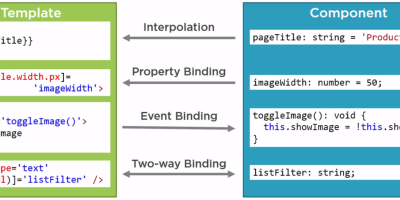Introduction:
When AngularJS first hit the market, it revolutionized web development by introducing two-way data binding, dependency injection, and other features that made building dynamic web applications easier. However, as the web evolved, so did the needs of developers. Angular 2+, often referred to simply as “Angular,” was introduced as a complete rewrite of AngularJS. It brought substantial improvements in performance, scalability, and developer experience. This article will explore the key differences between AngularJS and Angular 2+, highlighting why the latter is a better choice for modern web development.
1. TypeScript Integration:
One of the most significant changes in Angular 2+ is the adoption of TypeScript as its primary language. AngularJS was built on JavaScript, which is a loosely typed language. While JavaScript offers flexibility, it can lead to potential issues as the codebase grows, especially in large-scale applications.
Why TypeScript?
- Static Typing: TypeScript introduces static typing, which helps developers catch errors at compile-time rather than at runtime. This is especially useful in large projects where maintaining type consistency across the codebase is critical.
- Better Tooling: TypeScript comes with enhanced tooling support, such as autocompletion, code navigation, and refactoring. This makes the development process smoother and less prone to errors.
- OOP Features: TypeScript allows for Object-Oriented Programming (OOP) concepts like classes, inheritance, and interfaces, which Angular 2+ leverages for building structured and maintainable applications.
2. Component-Based Architecture:
In AngularJS, the application is built using controllers, services, and directives. This approach often led to issues with code reusability and maintainability as the project grew larger. Angular 2+ introduces a component-based architecture, where the UI of the application is divided into reusable components. Each component encapsulates its HTML, CSS, and logic, making it easier to manage.
Advantages of Components:
- Modularity: Components can be easily reused in different parts of the application or even in different projects, promoting modularity.
- Encapsulation: Each component in Angular 2+ is encapsulated, meaning the logic, styles, and template are self-contained. This prevents unintentional interference between different parts of the UI.
- Scalability: With components, building large applications becomes more manageable because you can break down complex UIs into smaller, testable, and reusable pieces.
3. Performance Improvements:
One of the biggest complaints about AngularJS was its performance, especially in large-scale applications with complex data-binding. Angular 2+ addresses these issues through various mechanisms:
- Ahead-of-Time (AOT) Compilation: Angular 2+ offers AOT compilation, which compiles the application during the build process rather than at runtime. This results in smaller bundle sizes and faster load times.
- Efficient Change Detection: Angular 2+ uses a more efficient change detection mechanism compared to AngularJS’s two-way data binding, which constantly monitors the entire model for changes. This makes Angular 2+ much faster, especially in larger applications.
- Lazy Loading: Angular 2+ supports lazy loading, which allows developers to load parts of the application only when they are needed, improving the initial load time of the app.
4. Improved Dependency Injection:
While AngularJS introduced the concept of dependency injection (DI), Angular 2+ takes it to the next level. In Angular 2+, the DI system is more flexible, allowing developers to inject services at different levels of the component tree.
Key Features:
- Hierarchical Dependency Injection: Angular 2+ uses a hierarchical DI system, meaning services can be scoped to specific components. This allows for better memory management and reduces the chance of unintended service sharing across unrelated components.
- Tree-shakable Providers: Services in Angular 2+ can be marked as tree-shakable, meaning they are only included in the final bundle if they are actually used in the application. This reduces bundle sizes and improves performance.
5. Modernized Tooling and Ecosystem:
Angular 2+ comes with an extensive ecosystem of tools that streamline the development process:
- Angular CLI: The Angular CLI (Command Line Interface) is a powerful tool that simplifies project setup, builds processes, and testing. It automates many tasks, from creating new components to optimizing builds for production.
- RxJS for Reactive Programming: Angular 2+ introduces RxJS (Reactive Extensions for JavaScript) for handling asynchronous operations like HTTP requests. RxJS enables developers to write more predictable and maintainable code by leveraging Observables, which provide a unified way to manage streams of data.
- Testing Tools: Angular 2+ is built with testing in mind. The framework integrates seamlessly with testing tools like Jasmine, Karma, and Protractor, making it easier to write and run unit and end-to-end tests.
6. Mobile-First Approach:
Unlike AngularJS, Angular 2+ was designed with mobile applications in mind. The framework is optimized for building fast, mobile-friendly Single Page Applications (SPAs). Features like AOT compilation, lazy loading, and service workers enable Angular 2+ apps to perform well on mobile devices, making it a go-to choice for Progressive Web Apps (PWAs).
Conclusion:
Angular 2+ is a significant upgrade from AngularJS, offering a modern, flexible, and performance-driven framework for web development. With its TypeScript integration, component-based architecture, improved performance, and robust tooling, Angular 2+ is ideal for building scalable, maintainable applications. Whether you’re working on small projects or enterprise-level applications, Angular 2+ provides the features and tools you need to succeed in the fast-paced world of web development.




Leave a Reply